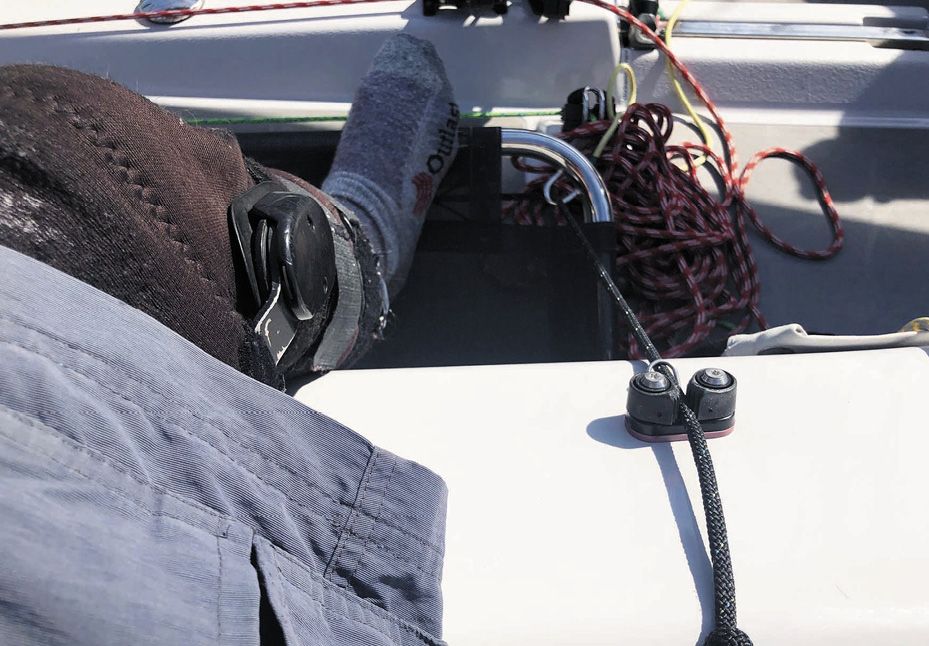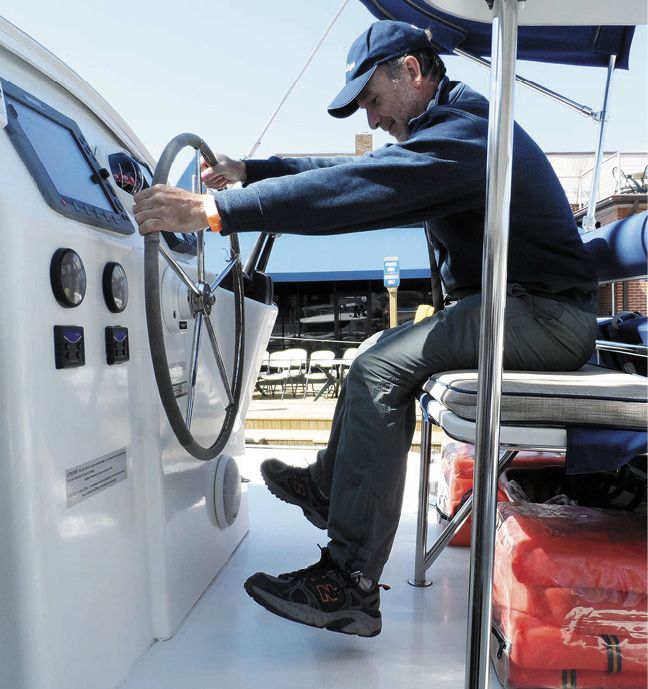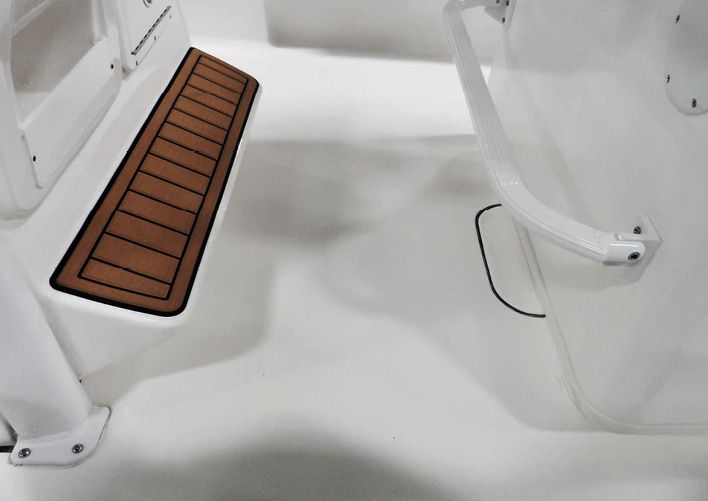The sensation that you are about to slide to leeward is familiar to most small-boat sailors. But that slip-sliding-away feeling isn’t reserved to small boats. Whether your boat is tiller steered or steered by a wheel, you’ll want a place to brace your feet. This is true whether close reaching or running. Good footing at the helm in a following sea can mean the difference between an exhilarating run and a knockdown.
On boats with narrower hulls, bracing your feet on the leeward seat is usually an easy and effective way to prevent sliding, but in the wider cockpits typical of today’s beamy monohulls, this option is literally out of reach. Today, nearly every builder has incorporated some form of footrest that crew can brace themselves against while sitting on a slant. But there is no one-size-fits-all foot brace and some designs are better than others.

It’s not just heeling that can provoke the need for a place to plant our feet. Even when the boat is level, the crew member hauling in the mainsheet or traveler will need a stable place to plant their feet.
In tender boats that readily heel, the need for a footrest is doubly important. You need a footrest not only to keep yourself seated as the boat heels in a gust, but also to be in a strong position for trimming a loaded mainsail.
If you think your cockpit needs foot braces, yet you are reluctant to install them because of the intrusion into the cockpit, you can try other means of improving footing. Start with high-traction deck shoes, an essential for the helmsperson. Most sailing shoes will provide reliable traction up to about 25 degrees of heel on a wet deck. Adding a grit-type, non-skid tape like 3M Safety Tread can help you stay put at angles up to 35 degrees, depending on the shoes (see “Non-skid Tape for Boats,” PS August 2018).

On many boats, molded cockpit structures designed primarily to serve another purpose can also provide a foot brace. You can prop a foot against the centerboard case, binnacle, or simply sit on the leeward side of the cockpit. But that won’t work on today’s wide-body boats with fat transoms and ballroom cockpits. An expansive beam sure seems comfortable and attractive at the dock, but it isn’t hard to imagine how uncomfortable and ugly things can get when that spacious cockpit is leaning sharply toward a cold sea with no place to plant a foot.
FOOT BRACE DESIGN
Yes, foot braces can be a tripping hazard, there is no easy way around that. Like sheets and lines on the cockpit floor, they are an inevitable reality that carry some risk. The hazards associated with foot braces can be moderated, however.

We’ve seen some cockpits cluttered with individual footrests spaced out along the cockpit sole. A single longitudinal rib that runs parallel to the cockpit seating creates less of a tripping hazard than a footrest minefield comprised of several small wedges that need to be conspicuous. Paint your footrests with a color that contrasts with the rest of the cockpit or cover them with contrasting non-skid tape.
Another way to keep seated crew in place is to install hinged, swing-out, footrests. Supported by a simple tackle, these adjustable footrests can be folded up when they are not needed. A retractable footrest can be handy on small, tiller-steered boats where a foot brace would be intrusive.

Securing a helmsperson who is sitting on the coaming can be more complicated. The higher position offers a better view of the horizon and the leading edge of the headsail, but this spot is more exposed to spray. Without any place to brace themselves, the person at the helm can slide right off their high perch when the boat heels.
Humps or high foot braces installed at the helm seat can provide good bracing when the helmsperson is seated athwartship, or on the cockpit coaming. When you are sitting behind the wheel, however, these humps and bumps are uncomfortable.

One compromise is to install teak chocks that are not quite as high as the helm seat cushion. The chocks keep the cushion in place on calm days. When the boat begins heeling, the centerline helm seat cushion is stowed below. The helmsperson can then sit on either coaming or with their back against it and brace their feet on the teak chocks.
The problem with this approach is that we must keep stowing and fetching the seat cushion as sea conditions change. At some point the helms-person might be without the cushion just when they want it—during rough seas that require an attentive hand at the helm. High friction seat cushions that are well secured with ties on the coaming itself can make this perch more comfortable, but a functional design might require some creative thinking.
Hanging your bottom outboard over the cockpit coaming is a third option. This not a comfortable position for long periods, but many people like this spot. Any fixed cushions will need to be well secured. You also will want to have a secure railing behind you, or, on a sport boat, dependable hiking straps. Once you are that far outboard, there is an increased risk of tumbling to windward in a lull.

FABRICATING FOOT BRACES
There are many ways to make your own foot braces. Sheet aluminum can be bent in a “V” shape. A table saw can create wedges from teak, rot-resistant western red cedar, or Azek (PVC appearance board). Coosa board or structural foam can be shaped and then covered with fiberglass cloth. Hinged, swing-out braces are most often fabricated from bent and welded stainless tubing, but composites also work very well.
The thought of drilling holes in the cockpit sole to install footrests can be daunting. On older boats, the sole is often a victim of water intrusion caused by a previous owner who failed to bed hardware. Be sure to seal any core when installing hardware.

You can avoid problems associated with drilling by bonding the braces in place. Foot braces are commonly low profile and have considerable surface area for bonding, so you don’t need screws. A high strength polyurethane adhesive sealant with an adhesive bond of about 300 pounds per square inch in shear load will provide plenty of strength. Assuming you have 20 square inches of bond area, your polyurethane-bonded footrest will technically hold about 6,000 pounds of load.
If you are bonding to fiberglass, or smooth gelcoat, very-high-bond tape might even be an option. We’ve tested it to up to 10 psi (sustained load) when bonded to a smooth surface. It must be smooth because a non-skid pattern will interfere with a good bond. Used correctly, VHB tape can withstand momentary impact loads of up to 1,000 psi. You can also bond the footrests with epoxy, which would provide more than enough bond strength.

CONCLUSION
Even a seemingly solid brace will fail at some angle of heel. When your center of gravity is directly vertical over your braced foot, you have no more leverage to hold you in place. As you approach that position, you might not have enough leverage to turn the wheel or tiller and counter weather helm.
The higher the brace point, the better, and this is the advantage of low seats and braces that can be adjusted higher. On a tender boat, if the crew loses position during a sharp heel, all control is lost. The crew tumbles to leeward, possibly injured and possibly overboard.
At what angle of heel are you pre-
pared to lose control and tumble? This is something to seriously consider when designing braces, or testing a boat that already has them installed. Ideally, you should to able to work efficiently at every station with the boat heeled 45 degrees or even more.
Rarely are you able to sharply heel a boat before you buy it, but if you move around the cockpit and try every seat for good foot bracing, you’ll get a good sense of how safe you will feel at sea. Many of the boats that we’ve tested seem fitted to men of average height, which leaves many shorter people literally hanging in the breeze.








































